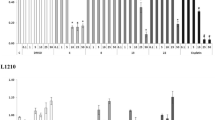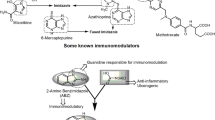Abstract
The effect of bucillamine [N-(2-mercapto-2-methylpropionyl)-l-cysteine] a new antirheumatic drug, on the concanavalin A (Con A)-induced proliferation of mouse spleen cells was compared with the effect ofd-penicillamine (d-pen). Bucillamine inhibited the Con A-induced incorporation of thymidine (TdR) into mouse spleen cells in a dose-dependent fashion. At the concentration of 10−4 M, bucillamine inhibited the incorporation by approximately 80%. The inhibitory effect of bucillamine was not enhanced by the addition of copper. In contrast,d-pen showed the same degree of inhibition only in the presence of copper. (4R)-7,7-Dimethyl-6-oxo-tetrahydro-3H-1,2,5-dithiazepine-4-carboxylic acid (SA981), an intramolecular disulfide derivative of bucillamine, also showed the same degree of inhibition as bucillamine in the absence and presence of copper, whereasd-penicillamine disulfide did not show the inhibitory effect even in the presence of copper. The inhibitory effects of bucillamine and SA981 were not abolished significantly by the addition of catalase which restored the inhibition byd-pen plus copper. The mechanism of inhibition byd-pen plus copper is believed to involve the production of hydrogen peroxide resulting from the oxidation ofd-pen. The results in this study, however, indicated that the inhibitory effect of bucillamine is not due to the production of hydrogen peroxide.
Similar content being viewed by others
References
C. Abe,Clinical evaluation of immunomodulators. Int. J. Immunother.1, 7–10 (1985).
S. Kashiwazaki and Y. Shiokawa,Bucillamine: A new immunomodulator. Int. J. Immunother.3, 1–6 (1987).
H. Fujimura, Y. Hiramatsu, Y. Tamura, M. Yanagihara, A. Koda, H. Nagai, K. Uda, T. Iso and H. Yamauchi,Pharmacological studies of new sulfyhdryl compounds 2-mercapto-2-methyl-propanoyl-L-cysteine. Folia Pharmacol. Japon.76, 117–129 (1980).
S. Kosaka, K. Itoh and K. Kumagai,An in-vitro study of SA-96 (DE-019), an immunomodulator, and its application in the treatment of rheumatoid arthritis.Tohoku J. Med. 96, 13–21 (1983).
M. Hayashi, C. Abe, H. Yamauchi, T. Iso and Y. Shiokawa,Effects of SA96 on self-defence system in Balb/c mice. Int. J. Immunother.1, 219–225 (1985).
M. Hayashi, C. Abe, R. T. Nozawa, T. Yokota, T. Iso and Y. Shiokawa,Effects of immunomodulators on candidacidal activity of normal peritoneal cells in BALB/c mice. Int. J. Immunopharmac.8, 299–304 (1986).
H. Yamauchi, K. Morikawa, M. Kuwano, M. Hikida, K. Fujimura, M. Horiuchi, O. Uemura and T. Iso,Pharmacological studies of N-(2-mercapto-2-methylpropionyl)-L-cysteine (SA96). Folia Pharmacol. Japon.86, 25–33 (1985).
K. Ishikawa and M. Sakaguchi,SA96 (N-(2-mercapto-2-methylpropanoyl)-L-cysteine) in rheumatoid arthritis. Scand. J. Rheumatol.15, 85–90 (1986).
H. V. Aposhian,Biochemical and pharmacological properties of the metal-binding agent penicillamine. Fed. Proc.20, 185–190 (1961).
J. M. Walshe,Penicillamine, a new oral therapy for Wilson's disease. Am. J. Med.21, 487–495 (1956).
G. Starkebaum and R. K. Root,D-Penicillamine: Analysis of the mechanism of copper-catalyzed hydrogen peroxide generation. J. Immunol.134, 3371–3378 (1985).
P. E. Lipsky and M. Ziff,The effect of D-Penicillamine on mitogen-induced human lymphocyte proliferation: Synergistic inhibition oby D-Penicillamine and copper salts. J. Immunol.120, 1006–1013 (1978).
P. E. Lipsky and M. Ziff,Inhibition of human helper T cell function in vitro by D-Penicillamine and CuSO 4. J. Clin. Invest.65, 1069–1076 (1980).
P. E. Lipsky,Immunosuppression by d-Penicillamine in vitro. J. Clin. Invest.73, 53–65 (1984).
Y. Takagi, M. Shikita, T. Terasima and S. Akaboshi,Specificity of radioprotective and cytotoxic effects of cysteamine in HeLa S 3 cells: Generation of peroxide as the mechanism of paradoxical toxicity. Radiat. Res.60, 292–301 (1974).
H. P. Misra,Generation of superoxide free radical during the autooxidation of thiols. J. Biol. Chem.249, 2151–2155 (1973).
S. Sugawara, M. Ishigami and T. Kageyama,Phase I study of N-(2-mercapto-2-methylpropionyl)-l-cysteine (SA96). (I) Single administration study. Rinsyo Yakuri16 611–620 (1985).
S. Sugawara, M. Ishigami and T. Kageyama,Phase I study of N-(2-mercapto-2-methylpropionyl)-l-cysteine (SA96). (II) Continuous 6-day administration study. Rinsyo Yakuri16, 621–630 (1985).
N. Morikawa, J. Matsumoto, H. Kito and T. Iso,Metabolic fate of N-(2-mercapto-2-methylpropionyl)-L-cysteine (SA96) (II). Absorption, distribution, metabolism and excretion during repeated administrations to male rats. Iyakuhin Kenkyu16, 808–817 (1985).
V. A. Ruiz-Torres, Zur Pharmakokinetik und zum Stoffwechsel vonD- andL-Penicillamin. II. Mitteilung: Verteilung vonD- andL-Penicillamin-14C im Organismus der Ratte nach peroraler Verabfolgung. Arzneim.-Forsch.24, 1043–1046 (1974).
Author information
Authors and Affiliations
Rights and permissions
About this article
Cite this article
Mita, S., Matsunaga, K. Differences in the effects of the antirheumatic drugs, bucillamine andd-penicillamine, on mitogen-induced proliferation of mouse spleen cells. Agents and Actions 30, 363–368 (1990). https://doi.org/10.1007/BF01966300
Received:
Accepted:
Issue Date:
DOI: https://doi.org/10.1007/BF01966300




